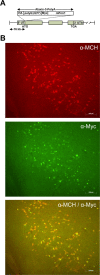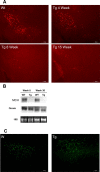Late-onset leanness in mice with targeted ablation of melanin concentrating hormone neurons
- PMID: 16407534
- PMCID: PMC6674397
- DOI: 10.1523/JNEUROSCI.1203-05.2006
Late-onset leanness in mice with targeted ablation of melanin concentrating hormone neurons
Abstract
The observation that loss of orexin (hypocretin) neurons causes human narcolepsy raises the possibility that other acquired disorders might also result from loss of hypothalamic neurons. To test this possibility for body weight, mice with selective loss of melanin concentrating hormone (MCH) neurons were generated. MCH was chosen to test because induced mutations of the MCH gene in mice cause hypophagia and leanness. Mice with ablation of MCH neurons were generated using toxin (ataxin-3)-mediated ablation strategy. The mice appeared normal but, after 7 weeks, developed reduced body weight, body length, fat mass, lean mass, and leptin levels. Leanness was characterized by hypophagia and increased energy expenditure. To study the role of MCH neurons on obesity secondary to leptin deficiency, we generated mice deficient in both ob gene product (leptin) and MCH neurons. Absence of MCH neurons in ob/ob mice improved obesity, diabetes, and hepatic steatosis, suggesting that MCH neurons are important mediators of the response to leptin deficiency. These data show that loss of MCH neurons can lead to an acquired leanness. This has implications for the pathogenesis of acquired changes of body weight and might be considered in clinical settings characterized by substantial weight changes later in life.
Figures







References
-
- Bittencourt JC, Presse F, Arias C, Peto C, Vaughan J, Nahon JL, Vale W, Sawchenko PE (1992) The melanin-concentrating hormone system of the rat brain: an immuno- and hybridization histochemical characterization. J Comp Neurol 319: 218–245. - PubMed
-
- Bornfeldt KE, Arnqvist HJ, Enberg B, Mathews LS, Norstedt G (1989) Regulation of insulin-like growth factor-I and growth hormone receptor gene expression by diabetes and nutritional state in rat tissues. J Endocrinol 122: 651–656. - PubMed
-
- Borsu L, Presse F, Nahon JL (2000) The AROM gene, spliced mRNAs encoding new DNA/RNA-binding proteins are transcribed from the opposite strand of the melanin-concentrating hormone gene in mammals. J Biol Chem 275: 40576–40587. - PubMed
-
- Bray GA, Gallagher Jr TF (1975) Manifestations of hypothalamic obesity in man: a comprehensive investigation of eight patients and a review of the literature. Med 54: 301–330. - PubMed
Publication types
MeSH terms
Substances
Grants and funding
LinkOut - more resources
Full Text Sources
Molecular Biology Databases
Miscellaneous
